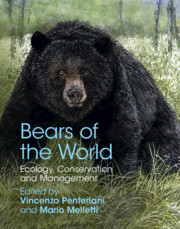Book contents
- Bears of the World
- Bears of the World
- Copyright page
- Dedication
- Frontispiece
- Contents
- Contributors
- Foreword
- Acknowledgments
- Introduction
- Part I Systematics, Ecology, and Behavior
- Part II Species Accounts
- Part III Human–Bear Coexistence
- Part IV Conservation and ManagementConservation and Management
- Chapter 20 Conservation and Management of Bears
- Chapter 21 How Is Climate Change Affecting Polar Bears and Giant Pandas?
- Chapter 22 Managing for Interpopulation Connectivity of the World’s Bear Species
- Chapter 23 Ex Situ Conservation of Bears: Roles, Status, and Management
- Chapter 24 The Challenge of Brown Bear Management in Hokkaido, Japan
- Chapter 25 Potential Ecological Corridors for Remnant Asiatic Black Bear Populations and its Subpopulations Linked to Management Units in Japan
- Chapter 26 Captive Bears in Asia: Implications for Animal Welfare and Conservation
- Chapter 27 Human Dimensions of Asiatic Black Bear Conflicts and Management in Japan
- Chapter 28 Ecological and Social Dimensions of Sloth Bear Conservation in Sri Lanka
- Index
- Miscellaneous Endmatter
- Plate Section (PDF Only)
- References
Chapter 23 - Ex Situ Conservation of Bears: Roles, Status, and Management
from Part IV - Conservation and ManagementConservation and Management
Published online by Cambridge University Press: 16 November 2020
- Bears of the World
- Bears of the World
- Copyright page
- Dedication
- Frontispiece
- Contents
- Contributors
- Foreword
- Acknowledgments
- Introduction
- Part I Systematics, Ecology, and Behavior
- Part II Species Accounts
- Part III Human–Bear Coexistence
- Part IV Conservation and ManagementConservation and Management
- Chapter 20 Conservation and Management of Bears
- Chapter 21 How Is Climate Change Affecting Polar Bears and Giant Pandas?
- Chapter 22 Managing for Interpopulation Connectivity of the World’s Bear Species
- Chapter 23 Ex Situ Conservation of Bears: Roles, Status, and Management
- Chapter 24 The Challenge of Brown Bear Management in Hokkaido, Japan
- Chapter 25 Potential Ecological Corridors for Remnant Asiatic Black Bear Populations and its Subpopulations Linked to Management Units in Japan
- Chapter 26 Captive Bears in Asia: Implications for Animal Welfare and Conservation
- Chapter 27 Human Dimensions of Asiatic Black Bear Conflicts and Management in Japan
- Chapter 28 Ecological and Social Dimensions of Sloth Bear Conservation in Sri Lanka
- Index
- Miscellaneous Endmatter
- Plate Section (PDF Only)
- References
Summary
This chapter presents an overview of ursids in captive facilities. Examples of how bear populations in zoos and rescue centres (i.e. ex situ) can support wild bear (i.e. in situ) conservation now and in the future are provided, and the potential for reintroduction of captive bears is also discussed.
- Type
- Chapter
- Information
- Bears of the WorldEcology, Conservation and Management, pp. 338 - 348Publisher: Cambridge University PressPrint publication year: 2020

